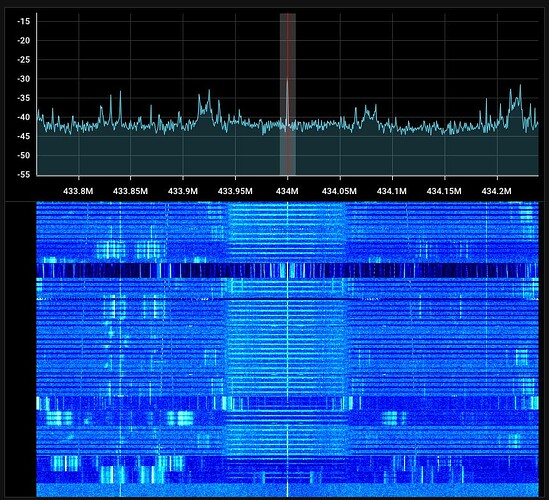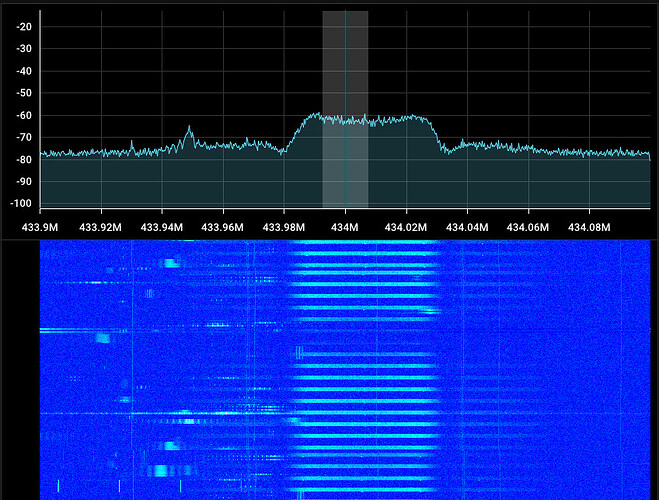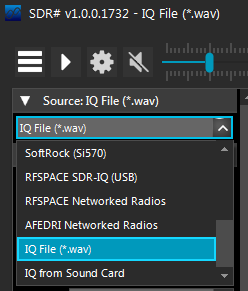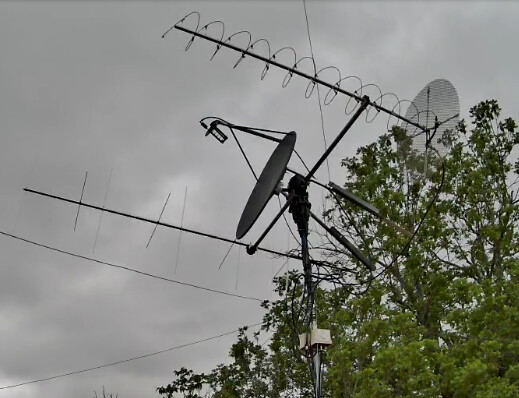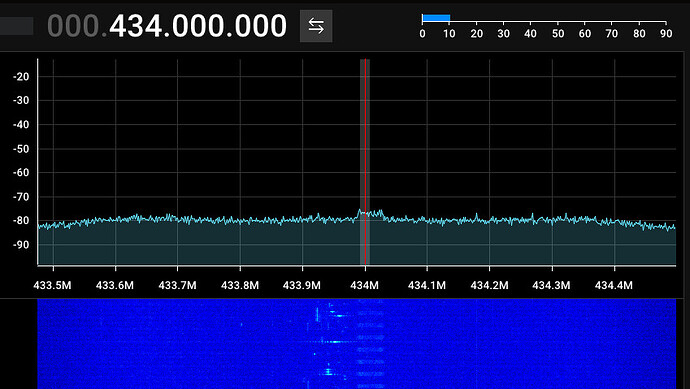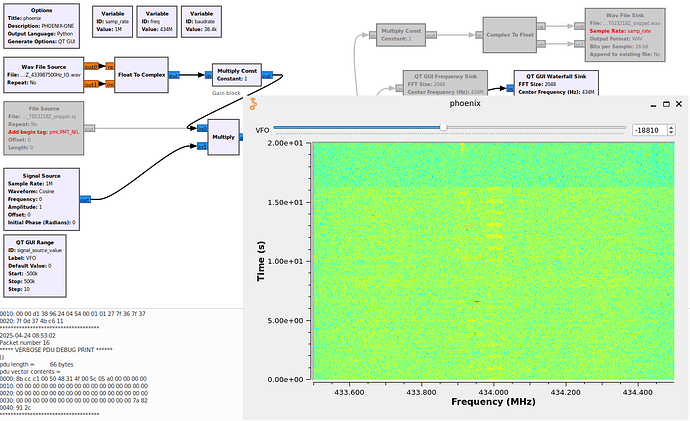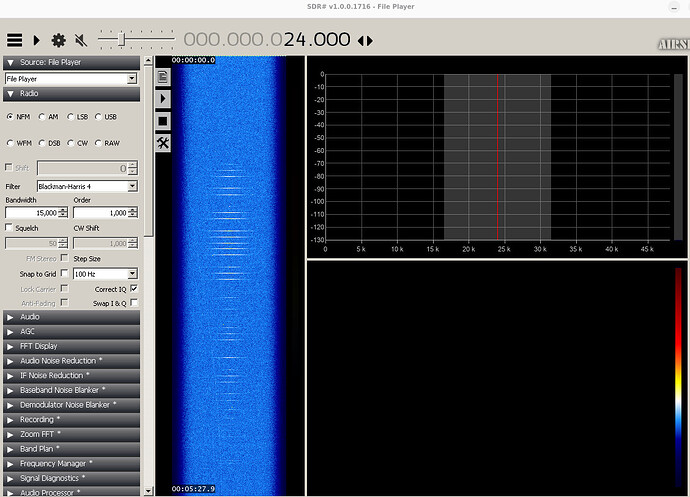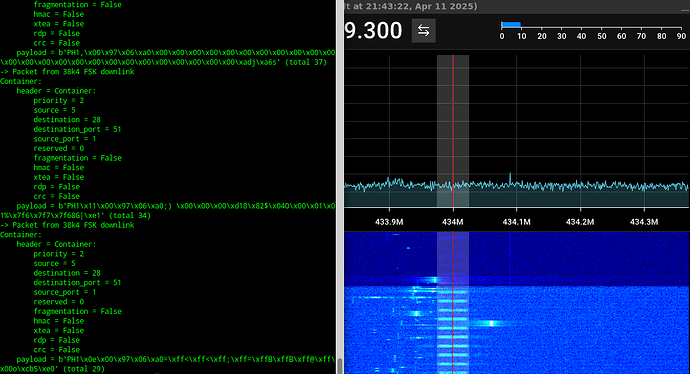It took a very long time but it did uploaded OK eventually. IQ recording here:
https://drive.google.com/drive/folders/1W0DEzJwpELb7A5Qtr3OfwCAgYUtW8T1b?usp=sharing
Please let me know if the file is accessible.
To all that shared IQ recordings, thank you very much.
I do have a question, can you please also share how the IQ was made, what software, sample rate and if you can the format.
Jan | PE0SAT
Yes it works perfect! Thank you!!!
Indeed that would be very helpful for post-processing the files!
Thanks for sharing the IQ files, I have been trying to use them in combination with several programs but I keep getting weird artifacts at the beginning and end of the pass band.
Can you share any extra details on how the IQ was recorded ?
Jan | PE0SAT
10el yagi, bandpass filter and SPF5183z LNA with RTL-SDR dongle on Raspberry Pi running local airspy server.
Then on desktop SDR# and IQ recording is 480ksps 8bit
Timestamp on the filename (UTC) GPS synced and EL83sc grid locator
Thanks,
A lot of ISM activity and an AGC seems to be kicking in, maybe try to lower the RTL gain and make sure AGC functionality is switched of.
Jan | PE0SAT
Jan I live in the middle of the country’s capital, tons of ISM transmitters all over the place. No AGC enabled at all… just LNA and RTL being overloaded by neighbors doorbells, garage automatic doors and motorcycles alarms keys. ![]()
These recordings look good, after a GQRX to SDR# format conversion I get the following result.
Any details on the setup, so that others can compare them with there own?
Jan | PE0SAT
Yep. At that point PH1 was bit higher above the horizon and heading to a place with less houses, thus less ISM QRM
Station details a bit higher above in another post
For this experiment it wouldn’t have helped in any way, but for other reception maybe experiment with some notch filter on 433 - 434 ? the link is a simple Coaxial Stub Notch Filter.
Well an stub notch might be still a bit too wide rolloff and might decrease a bit sensitivity on 435 MHz, it’s too close for homemade filters unless I try with a high Q cavity filter. But to be honest I don’t have too much of an issue with ISM while receiving 435-438, pretty much no QRM at all… but with PH1 in 434 it was really nothing I could do to filter that out
The SDR# was 32 bit ieee float
The SDR++ was also 32 bit float
both wav containers.
Both play back here with SDR# v1.0.0.1732 “IQ from File”
Hi Jan,
For “beam” data (which was not as good); M2 11 element 70 cm beam with horizontal elements. 10 foot LMR240 jumper to Mini-Circuits ZABP-450-S+ (400-510) bandpass filter, Airspy R2 to OrangePi Zero 3 running an Armbian linux OS with SpyServer.
For “helix” data (in this case gave a much better result!); 3 turn helix designed for 420 MHz. Basically a 6 gauge wire helix over a pizza pan supported by a PVC pipe. see - https://x.com/n6rfm/status/1896056356890951980; helix output to the same model band pass filter as above followed by ~ 20 dB wide-band preamp (Nooelec LaNA), 65 feet of LMR400UF to an Airspy Mini. All data were collected using GNURadio.
Credit to Scott K4KDR for getting me started with these helix antennas! They can be a bit noisy in an urban environment, but are are frequently my go-to antenna especially when TLEs are not well established and can perform amazingly well.
73,
Bob
Thanks David for sharing these details.
With this information and opening the IQ files with the option Float32 enabled the artifacts are no longer there and everything looks fine.

What is the reason for using Float32 and not the standard Int16
Decoding the IQ file was also possible.
Some frames:
************************************
2025-04-24 08:53:23
Packet number 20
***** VERBOSE PDU DEBUG PRINT ******
()
pdu length = 42 bytes
pdu vector contents =
0000: 8b cc c1 00 50 48 31 0b 00 68 85 c0 ff ff ae 11
0010: ff ff 80 6c ff ff ac 6e ff ec 77 23 00 61 32 ef
0020: ff 01 be 92 12 c7 ad 44 fe 7d
************************************
2025-04-24 08:53:33
Packet number 21
***** VERBOSE PDU DEBUG PRINT ******
()
pdu length = 42 bytes
pdu vector contents =
0000: 8b cc c1 00 50 48 31 0b 00 6d 05 c0 ff ff ab e7
0010: ff ff 70 57 ff ff ba 72 ff f7 90 16 00 5e cc 89
0020: fe fa a0 02 12 dc ca 02 60 82
************************************
2025-04-24 08:53:33
Packet number 22
***** VERBOSE PDU DEBUG PRINT ******
()
pdu length = 41 bytes
pdu vector contents =
0000: 8b cc c1 00 50 48 31 24 00 6d 05 c0 00 00 00 00
0010: 00 00 00 00 00 00 00 00 00 00 00 00 00 00 00 00
0020: 00 00 00 00 00 7a 0a 58 df
************************************
2025-04-24 08:53:33
Packet number 23
***** VERBOSE PDU DEBUG PRINT ******
()
pdu length = 41 bytes
pdu vector contents =
0000: 8b cc c1 00 50 48 31 2c 00 6d 05 c0 00 00 00 00
0010: 00 00 00 00 00 00 00 00 00 00 00 00 00 00 00 00
0020: 00 00 00 00 00 d7 d0 50 97
************************************
Jan | PE0SAT
Thanks for the feedback Jan and the decodes. I don’t know what I am doing most of the time is the reason.
Clear and thanks for the honesty ![]()
I saw you where using the IQ file open option, do you know there is also a great plugin (File Player) that gives you the ability to stop, pause, fast forward and fast reverse.
Below an example:
I wish more SDR programs would have this ability, my favorite when it comes to analyzing IQ recordings.
If you need help or information, let me known when you want to explore that plugin.
Jan | PE0SAT
Well I didn’t expect that this observation would produce valid PHOENIX frames.
The audio sample rate is only 48k3 and twice the satellites baud rate is 2 * 38k4 so shouldn’t “fit”
But it does:
gr_satellites PHOENIX-ONE.yml --wavfile 11452342.ogg --samp_rate 48e3 --hexdump
symbol_sync_ff :warning: block performing more interpolations per symbol (2) than input samples per symbol (1.25). Consider reducing osps or increasing sps
***** VERBOSE PDU DEBUG PRINT ******
((transmitter . 38k4 FSK downlink))
pdu length = 42 bytes
pdu vector contents =
0000: 8b cc c1 00 50 48 31 03 00 23 84 a0 ff ff 44 b2
0010: ff fb 75 9c ff ff 76 eb ff f0 d3 9d 00 4f 7e 41
0020: fc f9 77 d4 17 ee d7 58 72 f5
************************************
***** VERBOSE PDU DEBUG PRINT ******
((transmitter . 38k4 FSK downlink))
pdu length = 42 bytes
pdu vector contents =
0000: 8b cc c1 00 50 48 31 0b 00 23 84 a0 ff fe 88 cc
0010: ff fb e8 79 00 00 80 99 00 09 38 ff ff a2 cc 52
0020: fc f9 f5 ac 18 04 7e c3 0c 42
************************************
***** VERBOSE PDU DEBUG PRINT ******
((transmitter . 38k4 FSK downlink))
pdu length = 106 bytes
pdu vector contents =
0000: 8b cc c1 00 50 48 31 04 00 23 84 a0 00 65 20 03
0010: 02 59 01 1d ff c5 00 00 fa 14 ff ff ff ff 00 65
0020: 20 03 f6 fc 01 71 fc e5 ff ff f8 f0 ff ff ff ff
0030: 00 65 20 03 02 7b 01 42 fa 16 00 00 fa f0 ff ff
0040: ff ff 00 65 20 03 05 63 01 b5 fa a1 00 00 03 1b
0050: ff ff 00 00 00 65 20 03 01 9b 00 b3 00 2f 00 00
0060: ff 2f 00 00 ff ff 14 50 de 5d
************************************
***** VERBOSE PDU DEBUG PRINT ******
((transmitter . 38k4 FSK downlink))
pdu length = 119 bytes
pdu vector contents =
0000: 8b cc c1 00 50 48 31 10 00 23 84 a0 40 d7 c5 ca
0010: 40 00 00 00 7f f8 00 00 00 00 00 00 7f f8 00 00
0020: 00 00 00 00 7f f8 00 00 00 00 00 00 00 00 01 41
0030: 06 4b 81 60 00 00 00 00 00 00 00 00 00 00 00 00
0040: 00 00 00 00 00 00 00 00 00 00 00 00 00 00 00 01
0050: 3b 41 06 4a 99 40 00 00 00 00 00 00 00 00 00 00
0060: 00 00 00 00 00 00 00 00 00 00 00 00 00 00 00 00
0070: 00 01 3b d0 58 fa 0d
************************************
***** VERBOSE PDU DEBUG PRINT ******
((transmitter . 38k4 FSK downlink))
pdu length = 41 bytes
pdu vector contents =
0000: 8b cc c1 00 50 48 31 24 00 23 84 a0 00 00 00 00
0010: 00 00 00 00 00 00 00 00 00 00 00 00 00 00 00 00
0020: 00 00 00 00 00 8a 59 41 18
************************************
***** VERBOSE PDU DEBUG PRINT ******
((transmitter . 38k4 FSK downlink))
pdu length = 41 bytes
pdu vector contents =
0000: 8b cc c1 00 50 48 31 2c 00 23 84 a0 00 00 00 00
0010: 00 00 00 00 00 00 00 00 00 00 00 00 00 00 00 00
0020: 00 00 00 00 00 27 83 49 50
************************************
Jan | PE0SAT
And this is also working with a SDR++ replay and using the gr_satellites PHOENIX-ONE.yml --samp_rate 48e3 --audio option, using the IQ from @n5zkk

